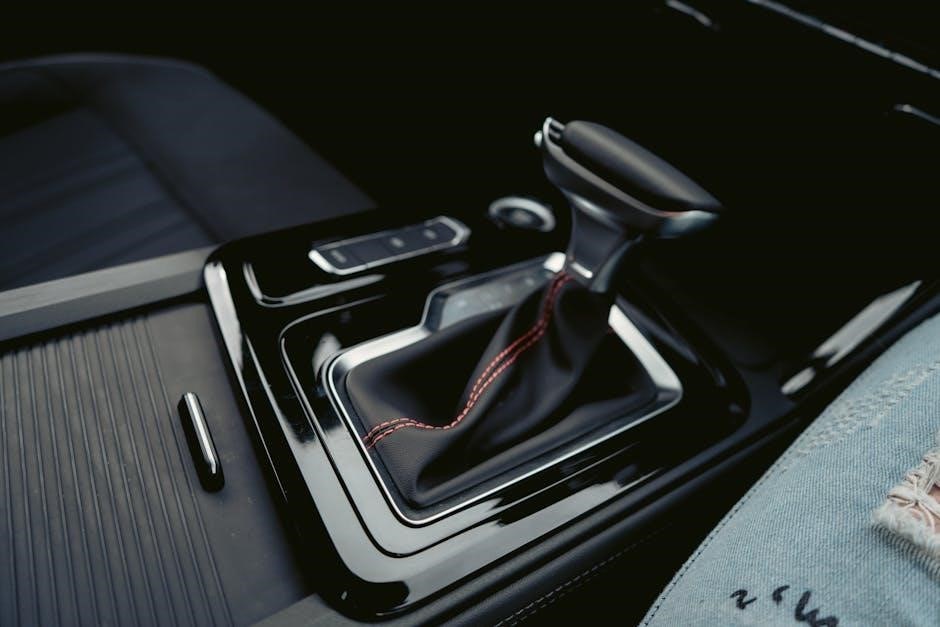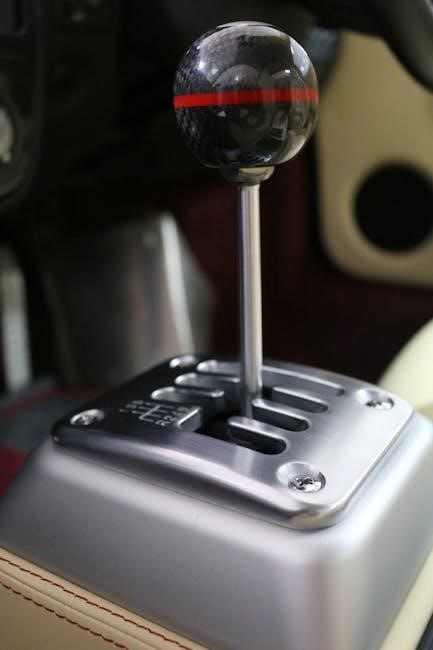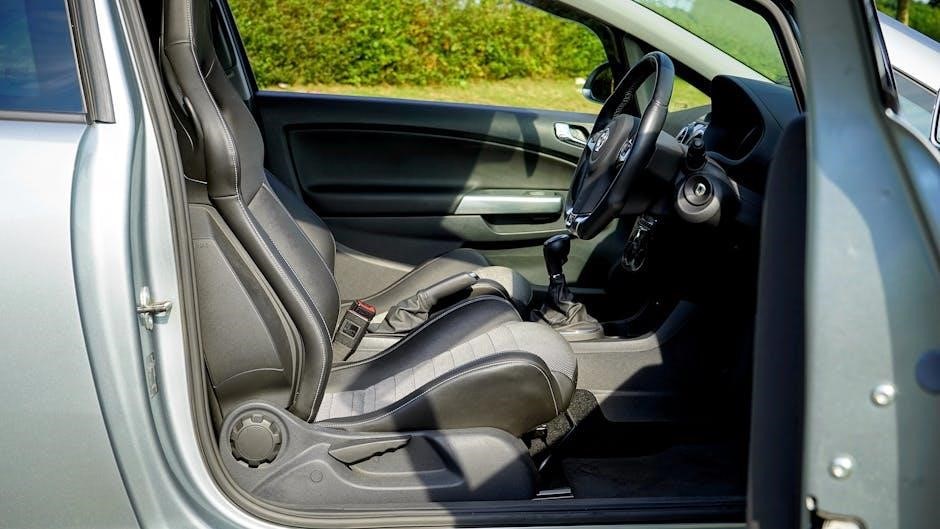Learning to drive a manual transmission car offers greater control and connection with the vehicle, making it a valuable skill for aspiring drivers worldwide.
Why Learning to Drive a Manual Car is Important
Mastering a manual transmission enhances driver control, improving fuel efficiency and driving precision. It also broadens car rental options while traveling and reduces vehicle costs, as manual cars are often more affordable. Additionally, driving a manual car fosters a deeper connection with the vehicle, making driving more engaging and enjoyable. These skills are valuable worldwide, especially in regions where manual cars are prevalent.
Overview of the Learning Process
Learning to drive a manual car involves understanding the basics of clutch and gear operation, starting with practice in a safe, open space. Beginners focus on smooth starts and stops, gradually progressing to shifting gears at the right speeds. Professional instructors often guide students through structured lessons, emphasizing coordination between the clutch, accelerator, and gearshift. The process begins with mastering low-speed maneuvers before advancing to more complex driving scenarios, ensuring a solid foundation for confident and competent driving.

Understanding the Mechanics of a Manual Transmission Car
A manual transmission car uses a clutch to disconnect the engine from the gears, allowing drivers to manually shift between gears for speed and torque control.

Key Components: Clutch, Gearshift, and Accelerator
The clutch, gearshift, and accelerator are essential for manual transmission driving. The clutch disconnects the engine from the wheels, allowing smooth gear shifts. The gearshift selects the appropriate gear, while the accelerator controls engine speed. Mastering their coordination is crucial for seamless driving.
How the Clutch and Gears Work Together
Pressing the clutch disconnects the engine from the wheels, allowing smooth gear shifts. Releasing the clutch while pressing the accelerator ensures the car moves without stalling. Proper timing is key for seamless acceleration and to avoid clutch wear. The clutch and gears work in harmony to transmit power efficiently, enabling drivers to control speed and torque effectively. This synchronization is vital for smooth driving, especially when shifting between gears during acceleration or deceleration on various terrains.

Basic Driving Techniques for Manual Cars
Mastering coordination between the clutch and accelerator is essential for smooth starts and gear shifts. Practice slow speed maneuvers to build muscle memory and control.
Starting from a Standstill and Shifting Gears
Starting from a standstill requires careful coordination between the clutch and accelerator. Press the clutch fully, shift into first gear, and slowly release the clutch while pressing the accelerator. As the car begins to move, gradually feed power by easing off the clutch and increasing accelerator input. For shifting gears, press the clutch, move the gearshift into the desired gear, and release the clutch smoothly while accelerating. Practice this process to ensure smooth transitions and avoid jerky movements, especially when shifting into higher gears as speed increases.
Mastering the Clutch and Accelerator Coordination
Mastering the clutch and accelerator coordination is essential for smooth manual driving. Start by pressing the clutch fully and shifting into first gear. As you release the clutch, simultaneously press the accelerator to avoid stalling. The key is to find the “biting point” where the engine begins to pull the car forward. Practice slow, smooth movements to synchronize the release of the clutch with the pressure on the accelerator. This coordination improves with practice, enabling seamless gear shifts and better control over the vehicle’s acceleration.

Common Challenges When Learning to Drive a Manual Car
Learning to drive a manual car often involves challenges like stalling, difficulty with smooth shifting, and coordinating the clutch and accelerator effectively. These issues are temporary and improve with practice.

Stalling the Car and How to Avoid It
Stalling is a common issue when learning to drive a manual car, often caused by improper clutch control or insufficient accelerator input. To avoid stalling, release the clutch slowly while pressing the accelerator gently. Practice starting on a flat surface to build coordination between the clutch and accelerator. Avoid riding the clutch, as this can wear it down and increase the likelihood of stalling. With consistent practice, smooth starts and stops become second nature, reducing the frequency of stalling incidents.
Difficulty with Smooth Shifting and Acceleration
Smooth shifting and acceleration can be challenging for new drivers, as it requires precise coordination between the clutch and accelerator. Jerky movements often result from releasing the clutch too quickly or not matching engine RPM to vehicle speed. To improve, focus on slow, deliberate clutch releases while gradually pressing the accelerator. Practice shifting through gears at the correct moments, such as when accelerating uphill or maintaining speed on flat roads. Consistent practice in a safe, open area helps develop muscle memory and smoother transitions between gears.

Practicing in Different Driving Conditions
Practicing in various conditions, such as heavy traffic, uphill terrain, and city driving, helps drivers master control and coordination, building confidence and skill behind the wheel.

Driving in Traffic and Uphill Terrain
Mastering manual transmission in traffic and uphill terrain requires precise clutch control and smooth shifting. In traffic, practice slow-speed maneuvers and quick gear changes to maintain flow. Uphill driving demands downshifting to maintain traction and avoid rolling backward. Use the handbrake on steep inclines and ensure proper gear selection for the gradient. These conditions enhance your ability to coordinate clutch and accelerator, building confidence in challenging environments.
Navigating Downhill and Braking Techniques
Navigating downhill in a manual car requires careful use of engine braking and gear selection. Downshift before descending to maintain control and avoid excessive brake use. Use lower gears to slow the car naturally, reducing strain on brakes. When braking, apply gentle, consistent pressure to avoid wheel lock-up. Proper downhill techniques enhance safety and control, especially on steep or winding roads. These skills are essential for mastering manual transmission driving in varied terrains.

Role of Professional Driving Lessons
Professional instructors provide expert guidance, helping learners master manual transmission skills through structured lessons and personalized feedback, ensuring safer and more efficient driving experiences from the start.
Benefits of Hiring a Certified Instructor
Hiring a certified instructor provides expert guidance tailored to your learning pace, ensuring mastery of manual transmission skills. Structured lesson plans focus on key areas like clutch control, smooth shifting, and real-world scenarios. Instructors offer personalized feedback, helping you overcome challenges and build confidence. Their experience reduces the risk of bad habits and ensures safe driving practices. With professional lessons, you gain practical experience in various conditions, from city traffic to uphill climbs, accelerating your learning process and making you a more competent driver.
Structured Lesson Plans for Manual Transmission Cars
Structured lesson plans for manual transmission cars are designed to progressively build skills, starting with basic clutch control and shifting techniques. Early sessions focus on mastering the fundamentals in a controlled environment, such as empty parking lots. As confidence grows, lessons introduce real-world scenarios, including uphill climbs, braking, and navigating traffic. Each phase incorporates hands-on practice and feedback, ensuring a comprehensive understanding of manual driving. This systematic approach minimizes frustration and accelerates the learning process, helping students become proficient drivers efficiently.

Safety Tips for Manual Transmission Drivers
Always wear a seatbelt, keep hands positioned correctly on the gearshift, and avoid distractions. Regularly check mirrors and maintain a safe distance from other vehicles.
Essential Safety Practices While Learning
Always wear a seatbelt and ensure passengers do the same. Keep hands positioned correctly on the wheel and gearshift. Avoid distractions like using a phone. Practice in open, low-traffic areas to minimize risks. Regularly check mirrors and maintain a safe distance. Keep both hands on the wheel while steering and shifting. Stay alert and focused, especially in challenging conditions. Follow instructor guidance and maintain a calm demeanor to avoid accidents and ensure a safe learning environment.
avoiding Common Mistakes That Lead to Accidents
Common mistakes include leaving the car in gear at red lights, which can cause rolling, and resting hands on the gear stick, leading to accidental shifts. Avoid using the clutch to hold the car on hills; instead, use the handbrake. Over-revving or aggressive acceleration can cause skidding. Stay focused, as distractions increase accident risks. Regularly check mirrors and blind spots. Avoid stalling by coordinating clutch and accelerator smoothly. Practice controlled braking and maintain a safe distance from other vehicles to minimize collision risks.
Mastering manual driving brings a sense of accomplishment and enhances your connection with the vehicle. It improves control, especially in challenging conditions, and boosts fuel efficiency. With consistent practice, you’ll gain confidence and become a skilled driver, ready to handle various road situations effortlessly.
Long-Term Benefits of Learning to Drive a Manual Car
Mastering a manual transmission offers long-term benefits, including better control over the vehicle, improved fuel efficiency, and enhanced driving skills. Drivers gain the ability to handle various road conditions more effectively, such as uphill climbs or sudden stops. Additionally, knowing how to drive a manual car provides flexibility, as it allows you to operate any manual vehicle worldwide. This skill also reduces car rental costs during travel and may lower insurance premiums in some regions. Overall, it fosters a deeper connection with driving and boosts confidence behind the wheel.
Final Tips for Becoming a Confident Driver
Consistent practice is key to becoming a confident driver. Start in a safe, open area to build comfort with clutch and accelerator coordination. Focus on smooth gear shifts and use mirrors frequently. Stay calm and patient, as mastery takes time. Seek feedback from instructors to refine your skills. Regular practice builds muscle memory, enhancing your driving abilities. With dedication, you’ll gain confidence to handle various road conditions effortlessly, ensuring a safer and more enjoyable driving experience.

